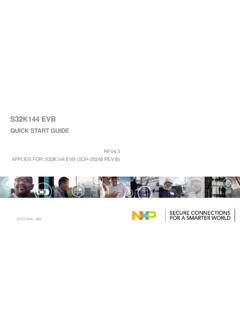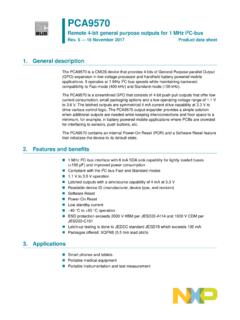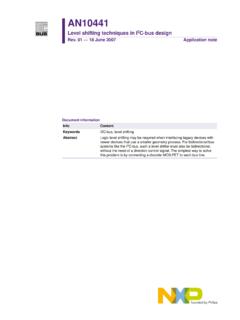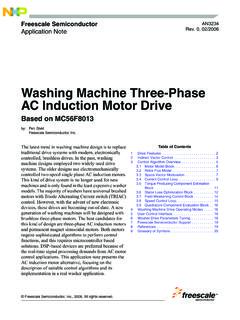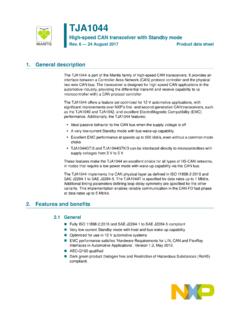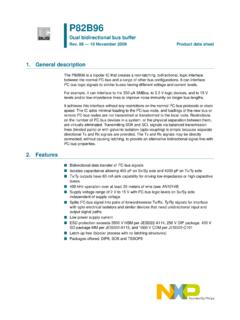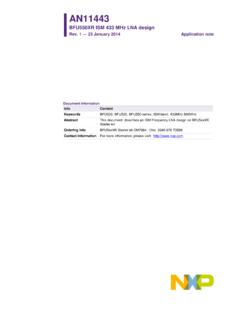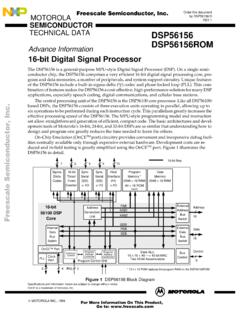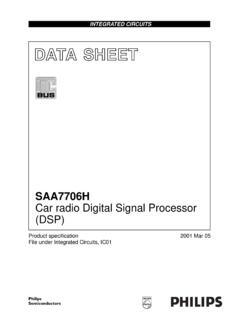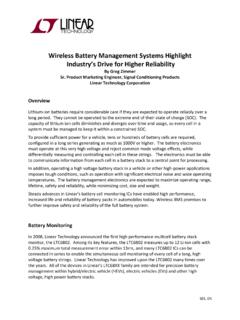Transcription of SMBus Quick Start Guide - NXP
1 Freescale SemiconductorApplication NoteDocument Number: AN4471 Rev. 1, 08/2012 Contents Freescale Semiconductor, Inc., 2012. All rights system management Bus ( SMBus ) is a two-wire interface through which various system component chips can communicate with each other and with the rest of the system . It is based on the principles of operation of I2C. SMBus provides a control bus for the system to pass messages to and from devices instead of using individual control lines, helping to reduce pin count and system wires. With SMBus , a device can: Provide manufacturer information Tell the system its model/part number Save its state for a suspend event Report different types of errors Accept control parameters Return its statusSMBus, first proposed by Intel in 1995, was designed to allow a battery to communicate with the charger, the 1 Introduction.
2 Topology .. 22 SMBus electrical specifications .. 33 Data transfers on SMBus .. 44 SMBus usage model .. 55 Using an SMBus device .. 76 Packet error checking .. 77 Bus protocols.. 88 Where SMBus is used .. 109 Differences between SMBus and I2C .. 1210MC9S08MP12/16 introduction.. 1311 References .. 1412 Summary .. 1413 Revision history ..15 SMBus Quick Start Guideby: Roger FanField Application EngineerSMBus Quick Start Guide , Rev. 1 IntroductionFreescale Semiconductor2system host, and/or other power-related components in the system . It was developed to enable an inexpensive, yet powerful method for controlling and getting information from devices attached to a notebook motherboard.
3 One of the goals of SMBus was to give digital capabilities to devices based on analog semiconductor technologies, thus creating a hybrid of the two. Many of the commands defined by SMBus are for simple logic implementations. SMBus devices do not need to implement all the commands defined in the SMBus specification. This makes the implementation of a SMBus driver for a SMBus support system much easier. The current SMBus specification is version The earlier version SMBus and specification was designed primarily with Smart Batteries in mind, though it could be used for other low-power devices.
4 The main difference between the earlier and current versions of the specification is that SMBus defines electrical characteristic classes for both low- and high-power topology SMBus devices in a system may be powered by the system bus VDD or by another power source (for example, the Smart Batteries powered by themselves). The following diagram shows such an implementation. The 5V VDD is the main power of this system and devices are powered by it. At the same time, there is another device that is powered by a 3V VBUS attached to the SMBus lines. These devices will inter-operate as long as they adhere to the SMBus electrical specifications.
5 An example of this implementation can be found in a system with a Smart Charger, powered by 5V and a Smart battery , powered by the device itself. Source: system management Bus Specification, version , Figure 2-1 Figure 1. SMBus topologyIt is generally known that, as with I2C, devices connected to the bus, the SMBCLK and SMBDAT lines, must have an open drain or open collector in order to perform the wired-AND function. Care should be taken in the design of both the input and output stages of SMBus devices in order not to load the bus when their power is turned off (that is, powered down devices must provide no leakage path to the ground).
6 3-"USDEVICE3-"#,+203-"USDEVICE3-"$!46"53 66$$ 6 SMBus electrical specificationsSMBus Quick Start Guide , Rev. 1 Freescale Semiconductor32 SMBus electrical specificationsAlthough the speed of the SMBus is specified from 10 KHz to 100 KHz, but most current implementations are in the range of 50 KHz to 100 KHz. Do not reduce the operating frequency to FSMB minimum even due to periodic clock extensions by slave devices. The device needs to be in the operational state within 500 ms after it is powered on. For a self-powered or always-powered device, this ready-for-operation criteria can be replaced by detecting the active state of SMBus (that is, the clock and data lines have gone high from low for more than seconds.)
7 Below is the timing diagram of SMBus and its AC and DC : system management Bus Specification, version , Figure 3-1 Figure 2. SMBus timing diagram Table 1. SMBus AC specification1 SymbolParameterLimitsUnitsMinMaxfSMBSMBu s operating frequency10100 KHztBUFBus free time between Stop and Start stHD:STAHold time after (repeated) Start condition. After this period, the first clock is stSU:STAR epeated Start condition setup stSU:STOStop condition setup stHD:DATData hold time300 nstSU:DATData setup time250 nstTIMEOUTD etect clock low timeout2535mstLOWC lock low stHIGHC lock high stLOW:SEXTC umulative clock low extend time (slave device) 25msSMBus Quick Start Guide , Rev.
8 1 Data transfers on SMBusFreescale Semiconductor43 Data transfers on SMBusThe SMBus uses fixed voltage levels to define the logic 0 (max ) and logic 1 (min ) on the bus, respectively. The data that appears on the SMBDAT line must be stable during the high period of the clock, and the data can only change state in the low period of the :MEXTC umulative clock low extend time (master device) 10mstFClock/data fall time 300nstRClock/data rise time 1000nstPORTime in which a device must be operational after power-on reset500ms1 Source: system management Bus Specification, version , Table 1 Table 2.
9 SMBus DC specification11 Source: system management Bus Specification, version , Table 2 SymbolParameterLimitsUnitsCommentsMinMax VILData, clock input low voltage , clock input high , clock output low voltage IPULLUP ,maxILEAKI nput leakage 5 A 22 Devices must meet this specification whether powered or unpowered. However, a microcontroller acting as an SMBus host may exceed ILEAK by no more than 10 through pullup resistor or current source100350 A33 The IPULLUP, MAX specification is determined primarily by the need to accommodate a maximum of equivalent series resistor of removable SMBus devices, such as the Smart battery , while maintaining the VOL, MAX of the bus to 5V 10%Table 1.
10 SMBus AC specification (continued)1 SymbolParameterLimitsUnitsMinMaxSMBus usage modelSMBus Quick Start Guide , Rev. 1 Freescale Semiconductor5 Source: system management Bus Specification, version , Figure 3-1 Figure 3. SMBus data transfer formatThe SMBus uses the ACK signal to detect the presence of detachable devices on the bus, so a device must always ACK its own address when the host accesses it. For other data bytes, the device can select ACK or NACK when receiving SMBus usage modelThe SMBus specification refers to three types of devices: host, master, and slave. A host is a specialized master that provides the main interface to the system 's CPU.
